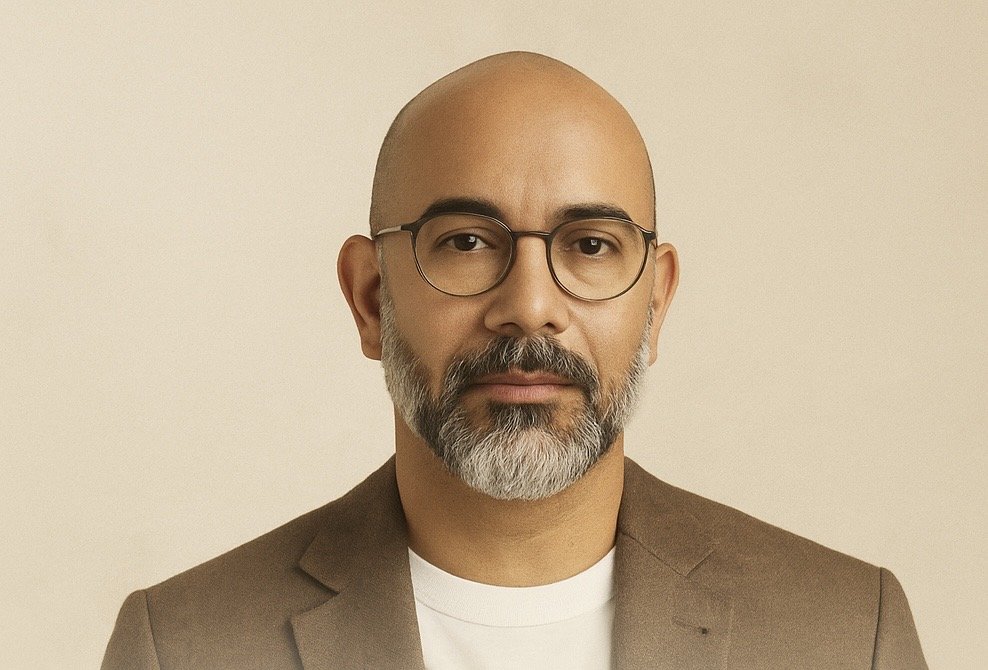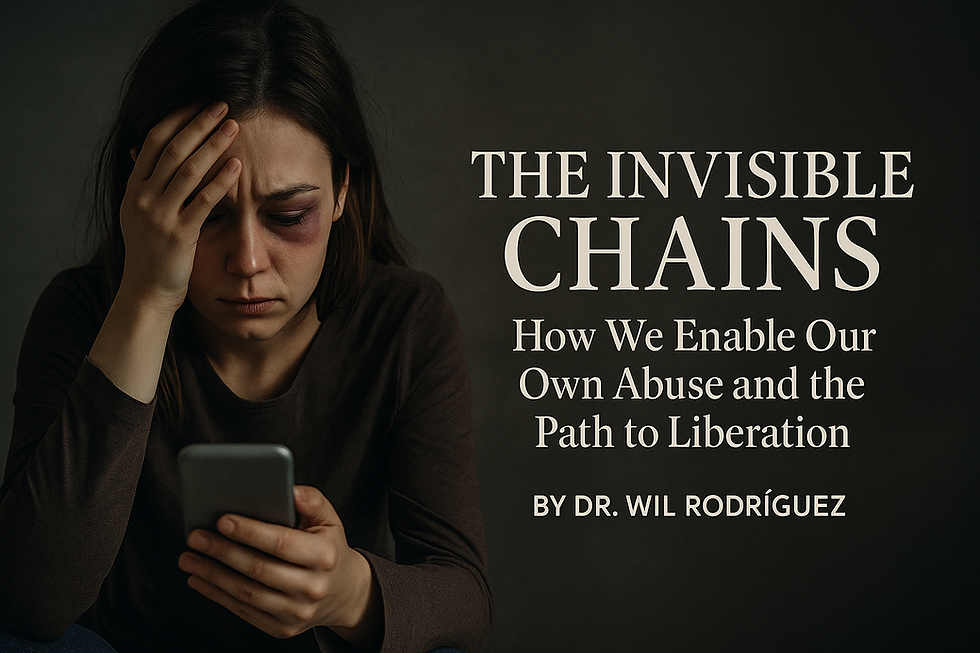The Invisible Chains: How We Enable Our Own Abuse and the Path to Liberation
- Dr. Wil Rodriguez

- 3 days ago
- 5 min read
This article addresses sensitive and challenging realities about love, relationships, and human behavior. Approach with openness and reflection.
By Dr. Wil Rodríguez | TOCSIN Magazine

Sarah stared at her phone screen, reading the text for the fourth time: “I’m sorry baby. You know I love you. I was just stressed from work. It won’t happen again.” Her jaw still throbbed from where his fist had connected two days earlier, but already she felt the familiar pull—the gravitational force of a toxic relationship drawing her back into orbit.
She wasn’t weak. She wasn’t stupid. She was trapped in one of humanity’s most insidious psychological prisons: the cycle of abuse. And like millions of others, she had unknowingly become complicit in her own captivity.
The statistics are staggering. Every minute, 24 people in the United States become victims of rape, physical violence, or stalking by an intimate partner—more than 12 million women and men annually. In fact, more than 16 million people suffer from intimate partner abuse per year. But these numbers only capture the visible violence. The psychological abuse, the subtle manipulation, the gradual erosion of self-worth—these leave no bruises but create wounds that run far deeper.
The Architecture of Abuse: Understanding the Cycle
The cycle of abuse, first documented in the 1970s by psychologist Lenore E. Walker, reveals a predictable pattern that repeats in abusive relationships. Understanding this cycle is crucial because it explains why intelligent, capable people remain trapped in relationships that seem obviously harmful to outsiders.
Stage 1: The Honeymoon Phase
This stage is characterized by love, intimacy, and charm. The abuser often seems “perfect,” leading the victim to feel loved and cherished. It’s during this phase that the victim’s emotional investment deepens. The abuser is attentive, apologetic, and promises change. This isn’t manipulation in the traditional sense—often, the abuser genuinely believes their own promises in these moments.
Stage 2: Tension Building
In this phase, the batterer gets edgy and tension begins to build up. The victim learns to “walk on eggshells,” constantly monitoring their partner’s mood, adjusting their behavior to avoid triggering an explosion. This creates a hypervigilant state that rewires the brain’s stress response system.
Stage 3: The Explosion
Outbursts of violence and abuse occur which may include verbal abuse and psychological abuse. The release of energy reduces the tension, and the abuser may feel or express that the victim “had it coming” to them. This is where the visible damage occurs—both physical and psychological.
Stage 4: Reconciliation
The perpetrator may begin to feel remorse, guilty feelings, or fear that their partner will leave or call the police. The cycle begins anew with promises, gifts, and renewed affection.
The Neuroscience of Stockholm Syndrome
What makes this cycle so powerful isn’t just psychological—it’s neurochemical. The intermittent reinforcement pattern created by the abuse cycle triggers the same reward pathways as gambling addiction. During honeymoon phases, the brain floods with dopamine and oxytocin. During abuse phases, stress hormones like cortisol create a chemical dependency on the eventual relief.
Dr. Patrick Carnes, a leading researcher in trauma bonding, explains that this creates “betrayal bonds”—powerful emotional attachments that form when someone alternates between kindness and cruelty. The victim’s brain literally becomes addicted to the abuser.
How We Enable Our Own Captivity
The harsh truth is that victims often become unconscious collaborators in their own abuse. This isn’t victim-blaming—it’s recognition of how trauma rewires our thinking patterns:
1. Minimization and Denial
“He only hits me when he’s drunk.” “She didn’t mean what she said.” “It’s not that bad—at least he doesn’t cheat.” The mind protects itself by downgrading the severity of abuse.
2. Isolation Acceptance
Abusers systematically isolate their victims from support networks. The victim gradually accepts this as normal, even preferable. “My friends don’t understand our relationship anyway.”
3. Identity Erosion
Over time, the victim’s sense of self becomes so intertwined with the abuser that leaving feels like psychological suicide. “Who am I without this relationship?”
4. Trauma Bonding
The shared intensity of the abuse cycle creates an artificial sense of intimacy. The victim mistakes this chemical bond for genuine love.
5. Learned Helplessness
Repeated failed attempts to change the abuser’s behavior teach the victim that resistance is futile. They stop trying to escape, even when opportunities arise.
The Economics of Abuse
The cost of intimate partner violence in the U.S. exceeds $8.3 billion annually. Survivors of intimate partner violence lose a total of 8 million days of paid work each year. But the personal economic cost is even more devastating. Abusers often control finances as a method of entrapment, leaving victims with no resources to escape.
This economic dependency isn’t accidental—it’s strategic. By controlling money, transportation, career opportunities, and social connections, abusers create a prison without bars.
Breaking the Chains: A Roadmap to Liberation
Liberation from abusive relationships requires more than just recognition—it demands a systematic dismantling of the psychological and practical barriers that keep victims trapped.
Step 1: Reality Recognition
The first step is always the hardest: accepting that the relationship is abusive. This requires:
Documenting incidents objectively
Reconnecting with trusted friends or family members
Seeking professional validation through counseling
Learning about abuse patterns to recognize them in your own experience
Step 2: Safety Planning
Physical and emotional safety must come first:
Identify safe spaces and people
Create an emergency escape plan
Secure important documents and resources
Establish a support network outside the relationship
Step 3: Financial Independence
Economic freedom is crucial for long-term liberation:
Open a private bank account
Develop job skills and resume
Research financial assistance programs
Create a secret emergency fund
Step 4: Psychological Healing
Breaking trauma bonds requires professional help:
Individual therapy to address underlying issues
Support groups with other survivors
Trauma-informed therapy techniques like EMDR
Medication if needed for depression or anxiety
Step 5: Building New Neural Pathways
Recovery means literally rewiring the brain:
Practice healthy relationship skills
Develop independent identity and interests
Learn to recognize manipulation tactics
Cultivate self-worth independent of relationships
The Liberation Movement
The most encouraging development in abuse recovery is the growing understanding that healing isn’t just individual—it’s collective. Support groups, online communities, and advocacy organizations are creating new models of recovery that address both personal and systemic issues.
Organizations like the National Domestic Violence Hotline (1-800-799-7233) provide 24/7 support, while apps like “My Plan” help victims create safety plans discreetly. The rise of financial abuse awareness has led to new programs that help survivors rebuild economic independence.
The Road Forward
Breaking free from abuse isn’t a single moment of clarity—it’s a process of gradual awakening. Every small act of resistance, every boundary set, every moment of self-advocacy is a step toward freedom.
The victim who starts quietly saving money. The person who reaches out to an old friend. The individual who googles “domestic violence help” at 2 AM. These aren’t signs of weakness—they’re acts of rebellion against a system designed to destroy their autonomy.
Recovery teaches us that we are not broken—we were broken. We are not helpless—we were made to feel helpless. And most importantly, we are not alone—we never were.
🪞 Reflection Box
Take a moment to honestly assess your current or past relationships:
Do you find yourself constantly adjusting your behavior to avoid your partner’s anger?
Have you isolated yourself from friends and family to avoid conflicts about your relationship?
Do you make excuses for your partner’s behavior to yourself or others?
Do you feel like you’re “walking on eggshells” most of the time?
Has your sense of self-worth become dependent on your partner’s approval?
If you answered yes to any of these questions, you may be experiencing emotional or psychological abuse. Remember: recognizing abuse is not weakness—it’s the first step toward strength.
🔥 Ready to dive deeper into the uncomfortable truths about modern relationships?
TOCSIN Magazine exposes the hidden dynamics that poison our most intimate connections. From narcissistic manipulation to cultural gaslighting, we investigate the toxic patterns that society pretends don’t exist.
Subscribe to TOCSIN Magazine for brutally honest analysis of:
Relationship red flags you’re ignoring
The psychology of manipulation
Recovering from emotional abuse
Building authentic connections in a fake world
Breaking generational trauma patterns
Because the first step to healing is admitting how deep the poison goes.
[SUBSCRIBE NOW] - www.tocsinmag.com







Commentaires